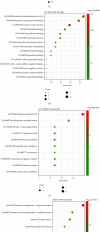Network Pharmacology-Based Strategy for Predicting Therapy Targets of Citri Reticulatae Pericarpium on Myocardial Hypertrophy
- PMID: 35281609
- PMCID: PMC8906983
- DOI: 10.1155/2022/4293265
Network Pharmacology-Based Strategy for Predicting Therapy Targets of Citri Reticulatae Pericarpium on Myocardial Hypertrophy
Abstract
Objective: Through a network pharmacology method, we screened the main active compounds of Citri Reticulatae Pericarpium (CRP), constructed a drug-ingredient-disease-target network, explored the molecular mechanism of its treatment of myocardial hypertrophy, and validated it by using molecular biology approach.
Methods: Traditional Chinese Medicine Systems Pharmacology (TCMSP) and GeneCards were utilised to collect the effective component in CRP and the targets of CRP and myocardial hypertrophy. The STRING database constructed the protein interaction network. The drug-ingredient-disease-target network was outlined by the Cytoscape 3.9.0 software. The Gene Ontology (GO) and Kyoto Encyclopedia of Genes and Genomes (KEGG) pathway enrichment analyses were conducted using the Metascape database. Real-time PCR (RT-PCR) and Western blotting were utilised to determine the mRNA and protein level of the critical targets of CRP therapy for myocardial hypertrophy.
Results: We found that five practical components of CRP exerted therapeutic effects on myocardial hypertrophy by modulating 41 targets. Further analysis revealed that naringenin was the essential active compound in CRP that regulated myocardial hypertrophy. In addition, we showed that the active compounds of CRP might exert antihypertrophy effects via regulating essential target proteins such as AKT1-, MAPK3-, PPARA-, PPARG-, and ESR1-mediated signaling pathways such as cell proliferation, nuclear receptor activation, and oxidative stress. The molecular biology experiments demonstrated that naringenin inhibited the mRNA level of NPPA and NPPB induced by Ang II and regulated related targets such as AKT1, MAPK3, PPARA, PPARG, and ESR1.
Conclusion: CRP could inhibit myocardial hypertrophy through multitarget and multiapproach.
Copyright © 2022 Shisheng Jiang et al.
Conflict of interest statement
The authors declare that they have no conflicts of interest.
Figures






Similar articles
-
[Network pharmacology research on high frequency use of Pericarpium Citri Reticulatae and Aucklandiae Radix herb pair in treatment of constipation with aromatic traditional Chinese medicine based on data mining].Zhongguo Zhong Yao Za Zhi. 2020 May;45(9):2103-2114. doi: 10.19540/j.cnki.cjcmm.20200221.304. Zhongguo Zhong Yao Za Zhi. 2020. PMID: 32495559 Chinese.
-
Network Pharmacology and Molecular Docking to Unveil the Mechanism of Shudihuang against Amyotrophic Lateral Sclerosis.Curr Pharm Des. 2023;29(19):1535-1545. doi: 10.2174/1381612829666230621105552. Curr Pharm Des. 2023. PMID: 37345246
-
A Network Pharmacology Study Based on the Mechanism of Citri Reticulatae Pericarpium-Pinelliae Rhizoma in the Treatment of Gastric Cancer.Evid Based Complement Alternat Med. 2021 Apr 16;2021:6667560. doi: 10.1155/2021/6667560. eCollection 2021. Evid Based Complement Alternat Med. 2021. PMID: 33953786 Free PMC article.
-
Exploration of the mechanism of Zisheng Shenqi decoction against gout arthritis using network pharmacology.Comput Biol Chem. 2021 Feb;90:107358. doi: 10.1016/j.compbiolchem.2020.107358. Epub 2020 Aug 8. Comput Biol Chem. 2021. PMID: 33243703 Review.
-
Integrated bioinformatics and network pharmacology identifying the mechanisms and molecular targets of Guipi Decoction for treatment of comorbidity with depression and gastrointestinal disorders.Metab Brain Dis. 2024 Jan;39(1):183-197. doi: 10.1007/s11011-023-01308-1. Epub 2023 Oct 17. Metab Brain Dis. 2024. PMID: 37847347 Review.
Cited by
-
Application of network pharmacology in synergistic action of Chinese herbal compounds.Theory Biosci. 2024 Sep;143(3):195-203. doi: 10.1007/s12064-024-00419-2. Epub 2024 Jun 18. Theory Biosci. 2024. PMID: 38888845 Review.
-
Insights into the Therapeutic Potential of Active Ingredients of Citri Reticulatae Pericarpium in Combatting Sarcopenia: An In Silico Approach.Int J Mol Sci. 2024 Oct 25;25(21):11451. doi: 10.3390/ijms252111451. Int J Mol Sci. 2024. PMID: 39519004 Free PMC article.
-
The Effect of Citrus aurantium on Non-Small-Cell Lung Cancer: A Research Based on Network and Experimental Pharmacology.Biomed Res Int. 2023 Jan 23;2023:6407588. doi: 10.1155/2023/6407588. eCollection 2023. Biomed Res Int. 2023. PMID: 36726839 Free PMC article.
-
Bioactive Compounds in Citrus reticulata Peel Are Potential Candidates for Alleviating Physical Fatigue through a Triad Approach of Network Pharmacology, Molecular Docking, and Molecular Dynamics Modeling.Nutrients. 2024 Jun 18;16(12):1934. doi: 10.3390/nu16121934. Nutrients. 2024. PMID: 38931288 Free PMC article.
References
-
- Vlad C. E., Foia L., Pavel-Tanasa M., et al. Evaluation of cardiovascular events and progression to end-stage renal disease in patients with dyslipidemia and chronic kidney disease from the North-Eastern area of Romania. International Urology and Nephrology . 2021;54:647–659. doi: 10.1007/s11255-021-02919-2. - DOI - PubMed
MeSH terms
Substances
LinkOut - more resources
Full Text Sources
Research Materials
Miscellaneous

